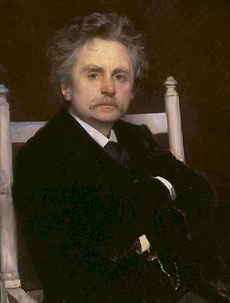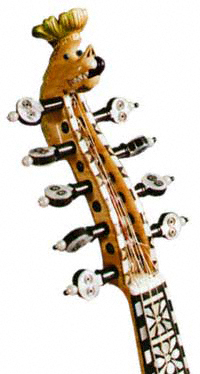

Edvard Grieg (1843-1907) was a Norwegian composer, conductor and pianist, and he composed 25 Norwegian Folksongs and Dances, Op. 17 in 1869. Grieg was an ardent supporter of Norwegian music, and he used Norwegian folk songs and dances as the basis for many of his compositions. He was raised in a musical family, and his mother, a pianist, taught him how to play the piano. When the internationally renowned Norwegian violinist Ole Bull heard Grieg play the piano, Ole Bull strongly encouraged Grieg’s parents to send their talented son to the prestigious Leipzig Conservatory. A few months later, Grieg was sent to study music at the Leipzig Conservatory (Grieg was 15 years old at the time).
Although Grieg studied with fine teachers at the Leipzig Conservatory, while he was there, his music and compositional style were largely shaped by German and Danish musicians. When Grieg was in his early 20s, he spent a summer with the violinist Ole Bull. Ole Bull was a strong advocate of Norwegian folk music, and under his tutelage, Grieg became very interested in Norwegian folk songs and Norwegian dance music (Grieg’s friendship with Ole Bull continued until Ole Bull’s death in 1880). Later that year, Grieg met the nationalist Norwegian musician Rikard Nordraak, and he too had an impact on Grieg’s emerging interest in Norwegian nationalism. Like Grieg, Nordraak had also been influenced by Ole Bull. Nordraak’s first public appearances as a musician took place when Ole Bull invited him to accompany him in concerts in 1859. Nordraak later became so well-known, that he was asked to compose the Norwegian national anthem. Grieg’s interactions with Ole Bull and Nordraak heavily influenced his decision to infuse his music with a Norwegian character, and Grieg did his best to help establish a distinctly Norwegian form of art music. Grieg was well known for his songs, piano music, chamber music, and orchestral music such as Peer Gynt, incidental music for a play by Henrik Ibsen (Grieg later extracted part of this music for two orchestral concert suites entitled Peer Gynt Suites No. 1 and 2). [10]
One of the instruments Grieg was intrigued by, was the Norwegian national instrument, the Hardanger fiddle. It is interesting to note that although Ole Bull helped promote the popularity of the Hardanger fiddle (and played on a Hardanger fiddle for some of his international tours), Ole Bull usually performed on his own modified violin and bow, altered after the manner of the Hardanger fiddle with a slightly shaved down bridge, and a bow longer and heavier than a traditional violin bow. [11]
The Hardanger fiddle (called Hardingfele in Norwegian) is a Norwegian folk instrument dating from approximately 1650, and is named for the region in which it originated (near the Hardanger fjord of Norway). Although the Hardanger fiddle has many similarities with the violin, it differs from the violin in the following ways:

As an example of Grieg’s interest in the Hardanger fiddle, Grieg's opening phrase from his Peer Gynt Suite No. 1 (Morning), is said to have been based on the sound of the Hardanger fiddle’s sympathetic strings. It should be noted, however, that Norway has two types of folk fiddles: the Hardanger fiddle, and the regular fiddle. Chris Goertzen observed that the regular fiddle has also played a prominent role in Norway’s folk song tradition. He further asserted that contribution made by the fiddle to Norwegian folk music has been unfairly eclipsed by the Hardanger fiddle’s distinctive appearance and unique status as a national symbol of Norway. Goertzen explained his viewpoint as follows:
The Hardanger fiddle has been intensively studied by both Norwegians and foreigners, while the fiddle has received much less scholarly attention from Norwegians and none from outsiders. The fiddle—physically the same as the violin—is played in the east, north, and in some parts of coastal Norway by as many fiddlers as devote themselves to the Hardanger fiddle, or more. Its tradition is at least as long as that of the Hardanger fiddle, and arguably more vigorous. [14]
Grieg composed his first set of Norwegian folksong arrangements in 1869: 25 Norwegian Folksongs and Dances, Op. 17, and this music was based on a collection of Norwegian folk tunes gathered by Ludvig Mathias Lindeman (1812-1887). Grieg dedicated his 25 Norwegian Folksongs and Dances, Op. 17 to Ole Bull, and one of Ole Bull’s favorite pieces in this collection was purportedly the Halling used in this arrangement (an 1881 publication of this piece noted "Ole Bull was especially fond of this Halling, and played it frequently"). [15]
TECHNIQUE TIPS: Halling is the name of a Norwegian folk dance, and it is usually in a fast, duple time (2/4 or 6/8). In Norway, halling dance music is played on both the Hardanger fiddle and the violin. As a dance, the halling is danced as a solo man’s dance to display strength and agility, and the dancer either kicks his foot high towards the ceiling, or kicks down a hat that is held up high. [16] The tempo of this arrangement of Halling is moderately fast (moderato), and the music should be played in a lively, vigorous manner. Some of the notes have dots over or under them, indicating they should be played with short, crisp bows. The last note of the piece is a triple stop, and to execute this bow stroke, play the bottom two notes of the chord first, then the top two notes of the chord.
© Copyright 2025 RK Deverich. All rights reserved.
Although this online violin class is provided free of charge, all rights are reserved and this content is protected by international copyright law. It is illegal to copy, post or publish this content in any form, and displaying any of this material on other websites, blogs or feeds is prohibited. Permission is given for individual users to print pages and perform music from this website for their personal, noncommercial use.